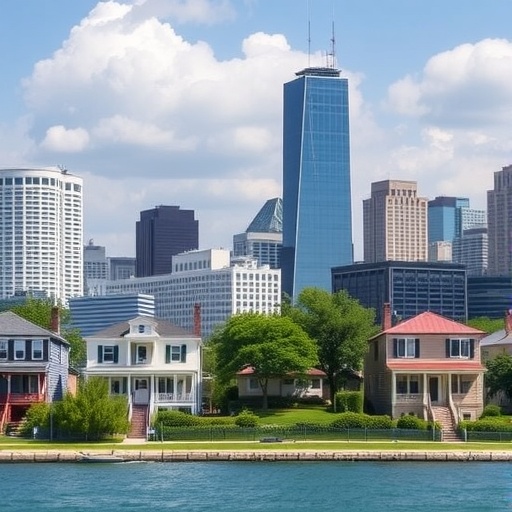The Lost Dream of Obam-a-Lago: Chicago’s South Shore Grapples with Housing Crises Amid Obama Presidential Center Backlash
In the shadow of what was meant to be a beacon of hope, Chicago’s South Shore neighborhood is crumbling under the weight of neglected properties and unfulfilled promises. The Obama Presidential Center, a $500 million project championed by former President Barack Obama, was supposed to revitalize this historic community. Instead, residents report skyrocketing rents, absentee landlords abandoning dilapidated buildings, and a housing crisis that has displaced families and eroded the area’s once-vibrant fabric. As construction delays and controversies mount, the dream of “Obam-a-Lago”—a playful nod to the project’s lakeside ambitions—has turned into a nightmare for locals battling housing issues in the Chicago South Shore.
Just blocks from the proposed site along Lake Michigan, boarded-up homes line streets where families once thrived. According to a recent report from the Chicago Housing Authority, over 30% of rental units in South Shore are in substandard condition, with absentee owners—many from out of state—failing to invest in maintenance. This isn’t abstract policy talk; it’s the daily reality for residents like Maria Gonzalez, a single mother of three who has watched her rent double since the Obama Presidential Center announcement in 2018. “We were told this would bring jobs and pride back to our community,” Gonzalez said in an interview. “But all it’s brought is higher bills and empty promises.”
The irony stings: a project named after a president who rose from Chicago’s streets now symbolizes gentrification fears. Data from the U.S. Census Bureau shows South Shore’s population dipped by 15% between 2010 and 2020, even as property values near the site surged 25%. Critics argue the Obama Presidential Center has accelerated displacement, with developers eyeing the area for luxury condos while low-income residents face eviction waves.
Obama Center Delays Spark Fury Over South Shore Displacement
The Obama Presidential Center, envisioned as a library, museum, and community hub, has been mired in delays since its groundbreaking in 2021. Originally slated for completion by 2026, the project now faces a potential 2027 timeline due to environmental reviews and legal challenges from preservationists. But for South Shore residents, the real controversy lies in its ripple effects on housing issues. Neighborhood advocacy groups like the South Shore Chamber of Commerce have documented a 40% increase in eviction filings since 2019, tying it directly to speculation around the center’s development.
Take the case of the Woodlawn Collaborative, a coalition of local nonprofits that sued the Obama Foundation over inadequate community impact assessments. “The foundation promised affordable housing commitments, but we’ve seen none,” said activist Jamal Green, who leads the group. Court filings reveal that while the project includes 20 acres of green space and educational facilities, only vague pledges exist for preserving existing homes. In response, the Obama Foundation issued a statement: “We remain committed to equitable development, with over $100 million invested in local workforce training and housing stabilization programs.” Yet skeptics point to similar flagship projects, like the Lucas Museum of Narrative Art, which also faced backlash for inflating local costs without broad benefits.
Statistics paint a grim picture. A 2023 study by the Metropolitan Planning Council found that Chicago South Shore has the highest rate of vacant properties in the city, with 1 in 5 buildings uninhabitable. Absentee landlords, who own 60% of rental stock according to city records, exacerbate this by collecting rents remotely while ignoring repairs. One notorious example is the Jefferson Park Apartments, a 50-unit complex where tenants endured leaking roofs and no heat for months before a city intervention in 2022 forced the out-of-state owner to sell.
Environmental factors compound the crisis. South Shore’s proximity to Lake Michigan makes it vulnerable to flooding, yet many aging buildings lack modern reinforcements. The Army Corps of Engineers reported in 2022 that unchecked erosion has damaged over 200 properties, but funding for resiliency measures has been slow to arrive—partly because development dollars are funneled toward high-profile projects like the Obama Presidential Center.
Absentee Landlords’ Grip Tightens on South Shore’s Decaying Housing Stock
At the heart of Chicago South Shore‘s housing issues are absentee landlords, faceless investors who treat properties like commodities rather than homes. A joint investigation by the Chicago Tribune and local housing watchdogs uncovered that 70% of South Shore’s multifamily buildings are owned by entities based outside Illinois, many in New York or California. These owners, profiting from federal subsidies like Section 8 vouchers, often neglect maintenance to maximize returns.
Consider the story of the Evergreen Terrace complex, a once-proud Art Deco building now synonymous with disrepair. Resident Evelyn Carter, 68, has lived there for 30 years. “The landlord hasn’t fixed the plumbing since Obama was president—ironically,” she quipped during a community forum. Leaks have led to mold infestations, and a 2023 health department inspection cited 15 violations, including exposed wiring. Despite tenant complaints, the owner, a Delaware-based LLC, has evaded fines by shuffling ownership through shell companies.
City data shows Chicago South Shore lost 1,200 affordable units between 2015 and 2023, many converted to market-rate or left vacant. The rise of institutional investors, post-2008 recession, has been a key driver. Firms like Blackstone and Invitation Homes scooped up foreclosed properties at bargain prices, only to hike rents by an average of 20%. A 2022 report from the National Low Income Housing Coalition ranked South Shore among the worst U.S. neighborhoods for housing affordability, with median rents at $1,200—up 35% in five years—while wages stagnate at $35,000 annually for many families.
Legal battles are mounting. In 2023, Illinois passed the Responsible Property Ownership Act, mandating stricter oversight of absentee owners, including mandatory local agents for repairs. But enforcement lags; only 15% of South Shore’s problem properties have been addressed. Community organizers are pushing back with “tenant unions,” like the one at the Lakeside Towers, where 80 residents successfully negotiated rent caps after a two-month strike.
- Key Stats on Absentee Ownership: 60% of rentals owned remotely; average repair backlog: 18 months; eviction rate: 2x city average.
- Impact on Families: 25% of children in South Shore live in substandard housing, per CDC data.
- Economic Toll: Vacant properties cost the city $50 million yearly in lost taxes and services.
Experts like urban planner Dr. Lena Ramirez from the University of Chicago argue that without targeted interventions, the Obama Presidential Center could catalyze a full exodus. “It’s a tale of two cities within one neighborhood,” she said. “The lakefront glitters, but the side streets rot.”
Community Voices Rise Against Gentrification Fears in Obama Era
From block club meetings to viral social media campaigns, Chicago South Shore residents are amplifying their struggles amid the Obama Presidential Center hype. “#SaveSouthShore” trended locally in 2023 after a viral video showed a family evicted from a condemned building just as foundation crews broke ground nearby. The clip, viewed 500,000 times, featured Darnell Wilkins, a veteran mechanic: “Obama fought for us, but this center feels like it’s fighting against us. Where do we go when the rents double?”
Quotes from the ground reveal deep frustration. At a town hall hosted by Alderman Stephanie Coleman, over 200 attendees demanded transparency. “The Obama name should mean progress for all, not just the wealthy,” said Coleman, who has introduced legislation for inclusionary zoning near the site. Local historian Dr. Marcus Hale added context: “South Shore was a hub for Black excellence in the 1960s, home to jazz legends and civil rights leaders. Now, housing issues threaten to erase that legacy.”
Positive stories emerge too. The South Shore Works initiative, funded partly by Obama Foundation grants, has trained 500 locals in construction trades, creating jobs tied to the center. Participant Keisha Thompson shared, “I’m building my future, literally, but I worry my neighbors won’t benefit.” Surveys by the group show 60% of residents support the project if it includes 30% affordable housing mandates—a stipulation still under negotiation.
Cultural resistance is strong. Artists like rapper Vic Mensa, a South Side native, have released tracks critiquing gentrification, drawing parallels to the Obama Presidential Center. Community gardens and pop-up markets on vacant lots serve as acts of defiance, fostering resilience amid disrepair.
Revitalization Roadblocks: Balancing Obama Legacy with Local Needs
As the Obama Presidential Center pushes forward, Chicago South Shore‘s housing issues demand urgent fixes. The city has allocated $75 million for a South Shore Housing Trust, aiming to acquire and rehab 1,000 units by 2025. Partnerships with groups like the Chicago Community Loan Fund are targeting absentee-owned properties for community land trusts, ensuring long-term affordability.
Yet challenges persist. A 2024 feasibility study by McKinsey & Company warns that without federal aid—potentially via the Infrastructure Investment and Jobs Act—displacement could worsen. The Obama Foundation has pledged $250 million for neighborhood investments, including a $50 million affordable housing fund, but rollout has been criticized as too slow.
Looking ahead, experts foresee a pivotal moment. If the center incorporates robust anti-displacement measures, like rent stabilization zones, it could redeem its promise. Mayor Brandon Johnson’s administration is exploring “community benefits agreements” to tie development to local hires and housing protections. Residents like Gonzalez remain cautiously optimistic: “We need action, not just symbols. Make South Shore shine for everyone.”
The path forward hinges on collaboration. With upcoming city council votes on zoning reforms and increased funding for code enforcement, Chicago South Shore could emerge stronger. The Obama Presidential Center, once a source of division, might yet become a catalyst for equitable revival—transforming the lost dream of Obam-a-Lago into a shared reality.








